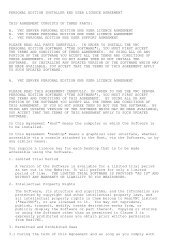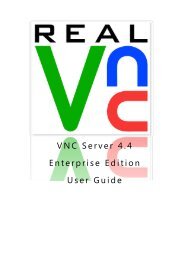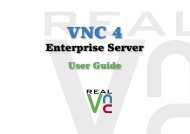VNC User Guide - RealVNC
VNC User Guide - RealVNC
VNC User Guide - RealVNC
Create successful ePaper yourself
Turn your PDF publications into a flip-book with our unique Google optimized e-Paper software.
Chapter 6: Setting Up <strong>VNC</strong> Server<br />
UNIX/Linux<br />
Under UNIX/Linux, a host computer user can log on and start <strong>VNC</strong> Server in <strong>User</strong> Mode. In this mode, <strong>VNC</strong><br />
Server runs attached to the console X Server session, which means that:<br />
• A <strong>VNC</strong> Server icon and <strong>VNC</strong> Server dialog are displayed in order to help the host computer user<br />
configure <strong>VNC</strong> Server after it has started, if necessary.<br />
• Connected users can access applications currently running on the host computer.<br />
• <strong>VNC</strong> Server stops, and all connections are terminated, when the host computer user starting <strong>VNC</strong><br />
Server logs off.<br />
• By default, in order to connect to:<br />
— <strong>VNC</strong> Server (Enterprise) or <strong>VNC</strong> Server (Personal), users must know the user name and password of<br />
the host computer user starting <strong>VNC</strong> Server.<br />
— <strong>VNC</strong> Server (Free), users must know the <strong>VNC</strong> password.<br />
Once connected, users have the same privileges (that is, access rights) as this host computer user. For<br />
more information on privileges, see Authenticating connections to <strong>VNC</strong> Server on page 98.<br />
Depending on the terms of your license, a host computer user can also, or alternatively, log on and start<br />
<strong>VNC</strong> Server in Virtual Mode. In this mode, <strong>VNC</strong> Server runs attached to a new virtual desktop, detached<br />
from the monitor and independent of the console. This means that:<br />
• No <strong>VNC</strong> Server icon or <strong>VNC</strong> Server dialog can be displayed in order to help the host computer user<br />
configure <strong>VNC</strong> Server after it has started. To see how to work with <strong>VNC</strong> Server in this mode, read<br />
Working with <strong>VNC</strong> Server in Virtual Mode on page 77.<br />
• Connected users cannot access applications currently running on the console of the host computer.<br />
Instead, an isolated workspace is provided. Note this powerful feature can help prevent conflicts; each<br />
user can be directed to connect to their own instance of <strong>VNC</strong> Server in Virtual Mode, and control a<br />
(virtual) desktop independently.<br />
• <strong>VNC</strong> Server does not stop when the host computer user logs off. <strong>User</strong>s stay connected, and new users<br />
can connect. <strong>VNC</strong> Server must be explicitly stopped.<br />
• By default, in order to connect to:<br />
— <strong>VNC</strong> Server (Enterprise) or <strong>VNC</strong> Server (Personal), users must know the user name and password of<br />
the host computer user starting <strong>VNC</strong> Server.<br />
— <strong>VNC</strong> Server (Free), users must know the <strong>VNC</strong> password.<br />
Once connected, users have the same privileges (that is, access rights) as this host computer user. For<br />
more information on privileges, see Authenticating connections to <strong>VNC</strong> Server on page 98.<br />
Under UNIX/Linux, more than one host computer user can log on at a time. Each currently logged on host<br />
computer user can start <strong>VNC</strong> Server in either mode, and all instances, for all users, run concurrently. Note<br />
that all instances must listen on different ports; see Configuring ports on page 88 for more information.<br />
<strong>VNC</strong> <strong>User</strong> <strong>Guide</strong> 79
















